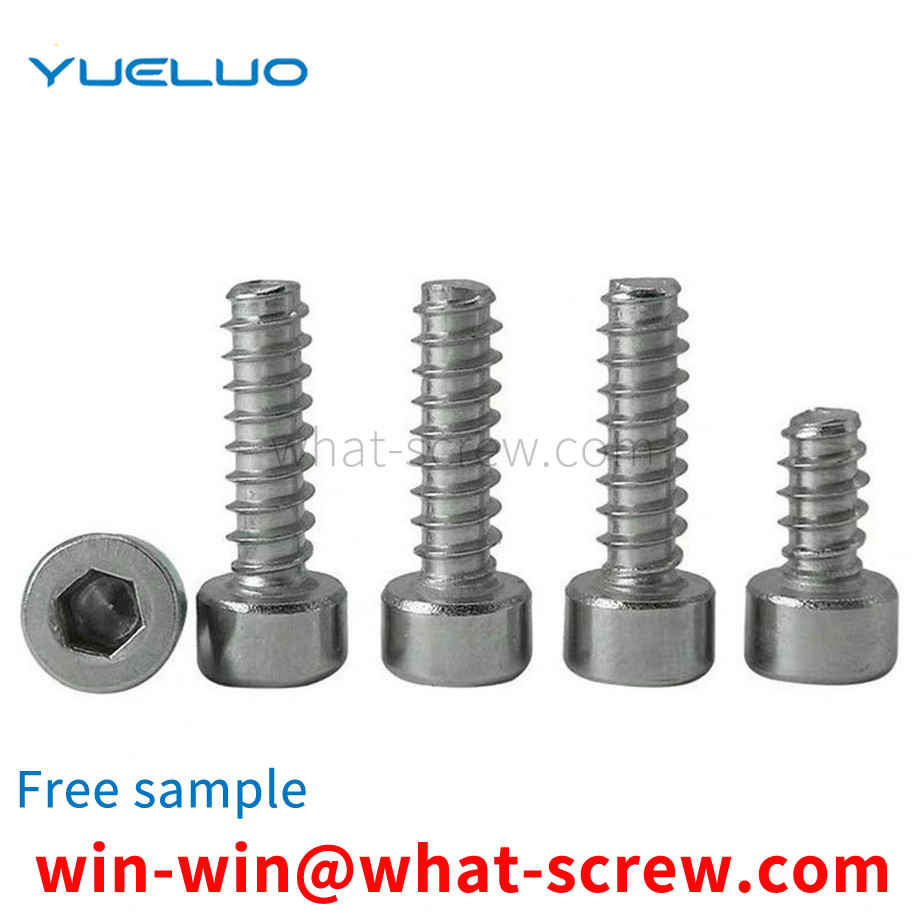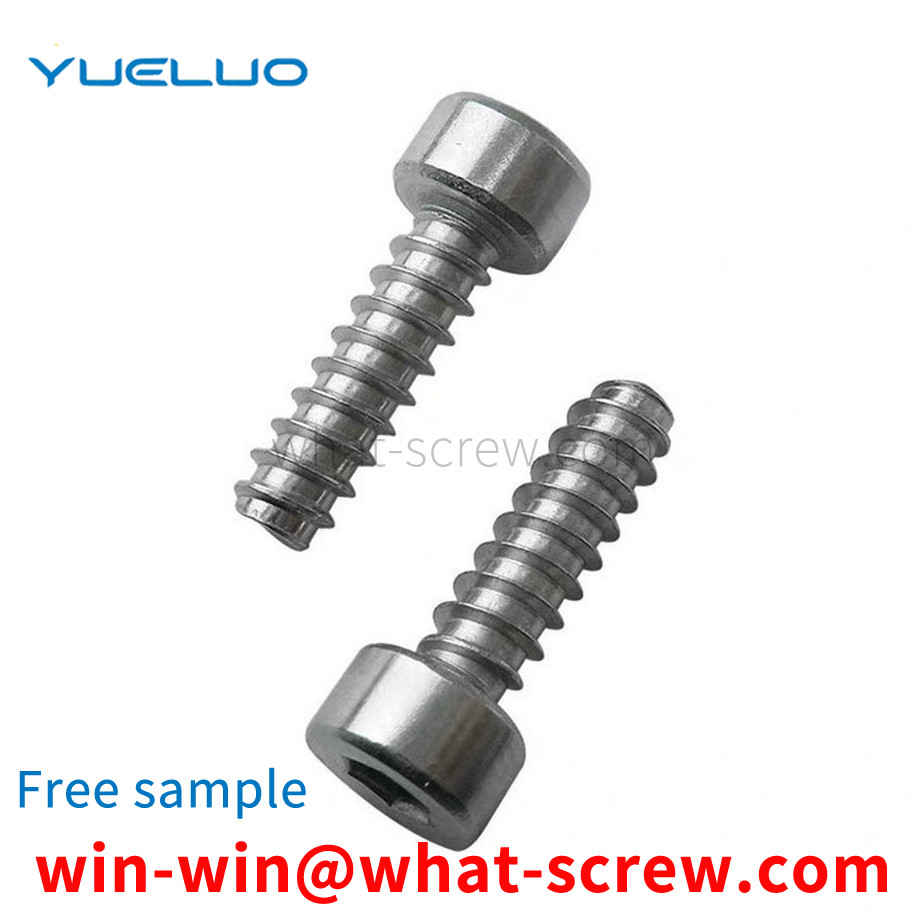The advantage of wood screws is that the consolidation ability is stronger than that of nails, and they can be removed and replaced, which is more convenient to use without damaging the wood surface. This is a kind of nail specially designed for wood, and after entering the wood, it will be embedded in it very firmly. If the wood is not damaged, it is impossible to pull it out, and even if it is pulled out forcibly, it will bring out the nearby wood. Another point to note is that the wood screws must be screwed in with a screwdriver. Never knock them in with a hammer, as it will damage the surrounding wood. A screwdriver is a tool for loading and unloading wood screws. The shape matches the groove shape of the wood screw head, and there are two types: one-word and cross-shaped. In addition, there is a special screwdriver installed on the bow drill, which is suitable for loading and unloading large wood screws. Convenient and labor-saving. [2]
Figure 1 is a schematic structural diagram of Guangdong Yueluo Hardware Industry Co., Ltd. Figure 2 is a front view of the structure of the riveted positioning block. FIG. 3 is a top view of the structure of the riveted positioning block. Figure 4 is a front view of the structure of the riveting lower die. Figure 5 is a side view of the structure of the riveting lower die. 1, I is a rivet, 2 is a riveting positioning block, 3 is a product, 4 is another product, and 5 is a riveting lower die. [0017] Referring to Figure 2, Figure 3, 2-1 is a positioning pin, 2-2 is a rivet hole, and 2-3 is a through hole. Referring to Figure 4, Figure 5, 5-1 is a positioning hole, 5-2 is a guide block, 5_3 is a countersunk screw hole, and 5_4 is a vacant hole.
The Greek mathematician Arkutas once described the principle of screw, screw, screw. In the first century AD, the Mediterranean world had begun to use wood screws, screws, and screws in screw presses that could press olive oil from olives, or make wine from grapes. Before the fifteenth century, metal screws, screws, screws were rarely used as fasteners in Europe. Rybczynski (Rybczynski) proves that hand-held screwdrivers and screwdrivers existed in the Middle Ages (at the latest AD 1580), but it was not until the eighteenth century that threaded fasteners were commercialized and began to be widely used. . Before threaded fasteners were widely used, there were many different ways of tightening. Mostly related to woodworking and forging, and less to machining, concepts such as dowels and pins, wedges, tenon and tenon, dovetails, nails, forge welding, and others are tied with leather or fiber and tied together. Before the mid-nineteenth century, ships were built with cotter pins, pin bolts, or rivets. There were also adhesives, but not as many as they are here today. Metal screws, screws, and screws became commonly used fasteners after the use of machine tools in the 18th century to mass-produce screws, screws, and screws. This technology developed around the 1760s and 1770s, along two separate processes. Approaches, but quickly converged: wood screws, screws, screws (metal screws for wood fixing, screws, screws) are machined with single-purpose, high-yield machines, and low-volume, mold shop style production V-Thread Machine Screws, Screws, Screws, can choose from a variety of different pitches.
Usually, the forming of the bolt head adopts cold heading plastic processing. Compared with the cutting process, the metal fiber (metal wire) is continuous along the shape of the product, and there is no cut in the middle, thus improving the strength of the product, especially the mechanical properties. The cold heading forming process includes cutting and forming, single-station single-click, double-click cold heading and multi-station automatic cold heading. An automatic cold heading machine performs multi-station processes such as stamping, heading forging, extrusion and diameter reduction in several forming dies. The processing characteristics of the original blank used by the single-station or multi-station automatic cold heading machine are determined by the size of the bar with a length of 5-6 meters or the wire rod with a weight of 1900-2000KG, that is, the characteristics of the processing technology. The point is that cold heading does not use pre-cut single blanks, but uses the automatic cold heading machine itself to cut and upset (if necessary) blanks from bars and wire rods. Before extruding the cavity, the blank must be shaped. A blank that meets the technological requirements can be obtained by shaping. Before upsetting, reducing and positive extrusion, the blank does not need to be shaped. After the blank is cut, it is sent to the upsetting and shaping station. This station can improve the quality of the blank, reduce the forming force of the next station by 15-17%, and prolong the life of the die, and the bolts can be made with multiple diameter reductions. The precision that can be achieved by cold heading is also related to the selection of the forming method and the procedure used. In addition, it also depends on the structural characteristics of the equipment used, the process characteristics and its state, the precision of the tool and die, the life and the degree of wear. For high-alloy steel used in cold heading forming and extrusion, the roughness of the working surface of the cemented carbide mold should not be greater than Ra=0.2um. When the roughness of the working surface of this type of mold reaches Ra=0.025-0.050um, it has the highest life.
According to the development and evolution process of self-tapping screws, we believe that the main types of self-tapping screws are as follows: 1. Common self-tapping screw threads are self-tapping threads, also known as wide thread. The surface is mostly electroplated. 2. Self-cutting and self-tapping screws are called scraping ends of self-tapping screws in my country's standard. The threads are self-tapping threads or machine threads, and the cross grooves are also H type. There are several types of self-cutting self-tapping screws: cross recessed pan head self-cutting self-tapping screws, cross recessed countersunk head self-cutting self-tapping screws. Cross recessed countersunk head self-cutting self-tapping screws, hexagon head self-cutting self-tapping screws. 3. Self-extrusion and self-tapping screws (self-tapping locking screws) The threads of self-extrusion and self-tapping screws are generally machine threads, and self-tapping threads are rarely used. In the wrenching method, in order to ensure the use of high-speed automatic assembly wrenches, slotting is generally not recommended. The cross section of the screw of the self-extrusion self-tapping screw is triangular. So it is also called triangular thread screw. 4. Self-drilling and self-tapping screws (self-drilling screws) The threads of self-drilling and self-tapping screws are self-tapping threads according to Chinese, German and international standards. In the American ASME and SAE standards, the BSD self-drilling self-tapping screws are self-tapping threads, and the CSD self-drilling self-tapping screws are machine threads. Self-drilling self-tapping screws are not recommended for slotted and normal hex head. 5. Metal driving screws (metal tapping screws) The metal driving screws have multiple threads and special threads with a certain helix angle. Only the American standard has metal drive screws, and there are no Chinese and German standards. 6. Wallboard self-tapping screws (dry wall screws) Wallboard white tapping screws are special threads with horn head, cross groove (H type) and 60° profile angle, and the surface is mostly phosphate treatment (phosphating). 7. The cross groove of the fiberboard nail is Z-shaped, and the surface treatment is mostly electroplating. There are several types of fiberboard nails: countersunk head, double countersunk head fiberboard nails, pan head, pan head flange (with pad) fiberboard nails, semi-countersunk head, semi-countersunk head flange (with cushion) fiberboard nails. 8. Combination self-tapping screws Ordinary self-tapping screws, self-cutting self-tapping screws, self-drilling self-tapping screws, etc., and flat washers, elastic washers (including spring washers, elastic locking washers, etc.). 9. Others Self-tapping screw types High and low thread double lead self-tapping screws, coarse and fine thread (different pitch) thread self-tapping screws, threads coated with sealing material (fall resistance) self-tapping screws, various composite groove self-tapping screws, Other special self-tapping screws, etc. In short, there are many types of self-tapping screws. With the development of production, the advancement of technology, new materials, new structures, and new thread forms, new self-tapping screw products will continue to appear.
We have many years of experience in the production and sales of screws, nuts, flat washers, etc. The main products are: GB6170 nuts, cotter pin positioning pins, 201 external hexagon bolts, chemical screws and other products, we can provide you with suitable fasteners for you solution.



















 Service Hotline
Service Hotline




